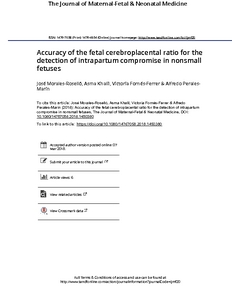Morales-Roselló, J; Khalil, A; Fornés-Ferrer, V; Perales-Marín, A
(2018)
Accuracy of the fetal cerebroplacental ratio for the detection of intrapartum compromise in nonsmall fetuses.
J Matern Fetal Neonatal Med, 32 (17).
pp. 2842-2852.
ISSN 1476-4954
https://doi.org/10.1080/14767058.2018.1450380
SGUL Authors: Khalil, Asma
![[img]](https://openaccess.sgul.ac.uk/109675/1.hassmallThumbnailVersion/21_03_2018_Accuracy%20o.pdf)  Preview |
|
PDF
Accepted Version
Available under License ["licenses_description_publisher" not defined].
Download (4MB)
| Preview
|
Abstract
OBJECTIVE: To study the accuracy of the cerebroplacental ratio (CPR) for the detection of intrapartum fetal compromise (IFC) in fetuses growing over the 10th centile. METHODS: This was a prospective study of 569 nonsmall fetuses attending the day hospital unit of a tertiary hospital that underwent an ultrasound examination at 36-40 weeks, and were delivered within 4 weeks of examination. IFC was defined as a composite of: abnormal intrapartum fetal heart rate or intrapartum fetal scalp pH < 7.20 requiring cesarean section, neonatal umbilical cord pH < 7.20, 5' Apgar score < 7 and postpartum admission to neonatal or pediatric intensive care units. The accuracy of CPR for the prediction of IFC was calculated alone and in combination with other perinatal parameters using univariate and multivariate logistic regression models, which alternatively included the onset of labor to evaluate the influence of induction of labor (IOL) on IFC and a brief composite adverse outcome of two parameters to prove the strength of the approach. RESULTS: The incidence of IFC was 17.9%. CPR sensitivity was 30.4% for a false positive rate (FFR) of 10 and 14.7% for a FPP of 5% (AUC = 0.62, p < 0.001). The multivariate analysis showed that only fetal gender and parity increased the predictive accuracy of CPR alone, although the improvement was poor (AUC = 0.67, p < 0.001). No differences were observed using any of the alternative models. Finally, IOL had no influence of IFC. CONCLUSION: Despite their apparent normality, a proportion of fetuses growing over the 10th centile suffer IFC. Some of them are suitable for detection by means of CPR.
Statistics
Item downloaded times since 22 Mar 2018.
Actions (login required)
 |
Edit Item |



